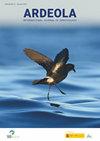小鸨的筑巢和孵化行为及其与孵化成功的关系
IF 1.2
4区 生物学
Q2 ORNITHOLOGY
引用次数: 3
摘要
2010年至2016年,我们在西班牙东北部埃布洛洼地的莱伊达平原,用GPS追踪了8只成年雌性小鸨的28窝卵,研究了它们的筑巢和孵化行为。除了描述这些行为外,我们还使用广义线性混合模型来确定决定孵化概率的因素,如产卵日期、筑巢栖息地和孵化行为。我们发现在巢故障后生产替换离合器的能力很高(53%)。不成功的卵窝占67.9%,主要是由于更换卵窝的孵化率低(16.7%),但首次卵窝的孵化率也低(44%)。失败的主要原因是遗弃巢穴或捕食(58%),而耕作方式导致38.9%的失败。我们发现,在孵化结束时,由于遗弃或捕食而导致失败的风险增加。产卵后期失败的风险更高,尽管这似乎与整个繁殖季节发生的谷物割草和筑巢基质的变化(从谷物到苜蓿)直接相关。同样地,我们发现发现巢穴的场地大小和周围栖息地对孵化概率有负面影响,我们将其与这些场地中雌性食物的可用性联系起来。旨在通过增加田间边缘密度和休耕时间来改善食物供应的措施,将有助于使母鸡在孵化前和孵化期间保持良好状态,并为更换雏鸡提供合适的栖息地。适宜的灌溉和刈割方式可提高雏鸟的孵化成功率。——库斯科,F.,博塔,G.,洛维特,A.和马诺萨,S.(2021)。小黑鸨的筑巢和孵化行为及其与孵化成功的关系。中国农业科学,68:95-122。本文章由计算机程序翻译,如有差异,请以英文原文为准。
Nesting and Incubation Behaviour of the Little Bustard Tetrax tetrax and Its Relation to Hatching Success
In 2010-2016, we monitored 28 clutches of eight adult Little Bustard Tetrax tetrax females tracked by GPS on the Lleida Plain, in the Ebro Depression (NE Spain), to study nesting and incubation behaviour. In addition to describing these behaviours, we used generalised linear mixed models to identify the factors that determine hatching probability, such as laying date, nesting habitat and incubation behaviour. We found a high capacity (53%) to produce replacement clutches following nest failure. Unsuccessful nests represented 67.9% of clutches, mainly due to the low hatching rate of replacement clutches (16.7%) but also of the first clutches (44%). The main causes of failure were nest abandonment or predation (58%), while farming practices were responsible for 38.9% of failures. We found an increased risk of failure due to desertion or predation towards the end of the incubation. The risk of failure was higher in late clutches, although this seemed to be directly related to cereal mowing and to changes in nesting substrate, from cereal to alfalfa, which occurred throughout the breeding season. Likewise, we found a negative effect of the size of the field where the nest was found and of the surrounding habitat on the hatching probability, which we related to the availability of food for the female in these fields. Measures aimed at improving food provision, by increasing field edge density and fallow availability, would help to maintain hens in good condition prior to and during incubation, as well as providing suitable habitat for replacement clutches. Adaptive irrigation and mowing patterns in alfalfa fields during the nesting season could contribute to increasing the hatching success of replacement clutches.—Cusco, F., Bota, G., Llovet, A. & Manosa, S. (2021). Nesting and incubation behaviour of the Little Bustard Tetrax tetrax and its relation to hatching success. Ardeola, 68: 95-122.
求助全文
通过发布文献求助,成功后即可免费获取论文全文。
去求助
来源期刊
CiteScore
2.30
自引率
6.20%
发文量
16
审稿时长
>12 weeks
期刊介绍:
Ardeola: International Journal of Ornithology is the scientific journal of SEO/BirdLife, the Spanish Ornithological Society. The journal had a regional focus when it was first published, in 1954. Since then, and particular during the past two decades, the journal has expanded its thematic and geographical scope. It is now a fully international forum for research on all aspects of ornithology. We thus welcome studies within the fields of basic biology, ecology, behaviour, conservation and biogeography, especially those arising from hypothesis-based research. Although we have a long publication history of Mediterranean and Neotropical studies, we accept papers on investigations worldwide.
Each volume of Ardeola has two parts, published annually in January and July. The main body of each issue comprises full-length original articles (Papersand Review articles) and shorter notes on methodology or stimulating findings (Short Communications). The publication language is English, with summaries, figure legends and table captions also in Spanish. Ardeolaalso publishes critical Book Reviewsand PhD-Dissertation Summaries; summarising ornithological theses defended in Spain. Finally there are two Spanish-language sections, Ornithological News; summarising significant recent observations of birds in Spain, and Observations of Rare Birds in Spain, the annual reports of the Spanish Rarities Committee.

 求助内容:
求助内容: 应助结果提醒方式:
应助结果提醒方式:


